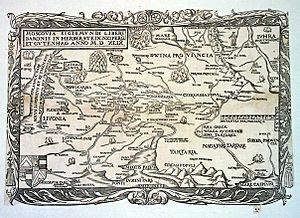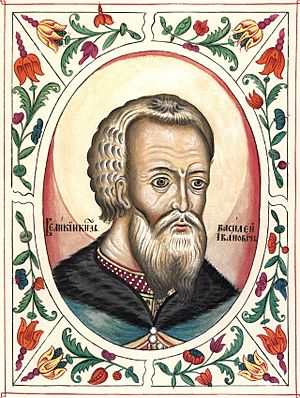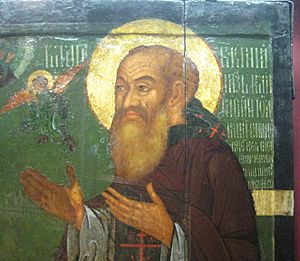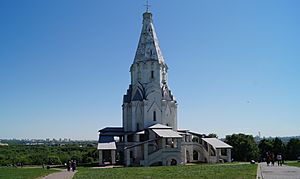Vasili III of Moscow facts for kids
Quick facts for kids Vasili III |
|||||
|---|---|---|---|---|---|
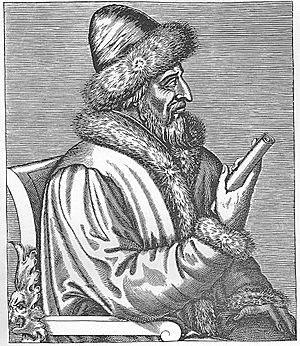
Vasili III Ivanovich, an engraving by a contemporary European artist.
|
|||||
| Grand Prince of Moscow | |||||
| Reign | 6 November 1505 – 3 December 1533 | ||||
| Coronation | 14 April 1502 | ||||
| Predecessor | Ivan III | ||||
| Successor | Ivan IV | ||||
| Born | 25 March 1479 Moscow, Grand Duchy of Moscow |
||||
| Died | 3 December 1533 (aged 54) Moscow, Grand Duchy of Moscow |
||||
| Burial | Archangel Cathedral | ||||
| Consort | Solomonia Saburova Elena Glinskaya |
||||
| Issue | George Vasilevich (rumoured) Ivan the Terrible Yuri Vasilevich |
||||
|
|||||
| Dynasty | Rurik | ||||
| Father | Ivan III of Moscow | ||||
| Mother | Sophia Paleologue | ||||
| Religion | Eastern Orthodox | ||||
Vasili III Ivanovich (Russian: Василий III Иванович, 25 March 1479 – 3 December 1533) was a very important ruler in Russian history. He was the Grand Prince of Moscow from 1505 to 1533. Vasili was the son of Ivan III Vasiliyevich and Sophia Paleologue. When he was christened, he was given the name Gavriil. He had three younger brothers and five sisters.
Expanding Moscow's Power
Vasili III continued the work of his father, Ivan III. He spent most of his time making Moscow's lands bigger and stronger. He added the last independent areas to Moscow. These included Pskov in 1510, Volokolamsk in 1513, Ryazan in 1521, and Novgorod-Seversky in 1522.
Vasili also took advantage of problems faced by Sigismund of Poland. This allowed him to capture Smolensk. Smolensk was a very important fortress in Lithuania. The siege started in 1512 and ended in 1514. Prince Mikhail Glinski, a Lithuanian rebel, helped Vasili with cannons and engineers. Losing Smolensk was a big defeat for Lithuania in the Russo-Lithuanian Wars.
In 1521, Vasili welcomed a visitor from the Safavid Empire in Iran. The Shah, Ismail I, wanted to form an alliance with Moscow. They both had a common enemy: the Ottoman Empire.
Vasili was also successful against the Crimean Khanate. In 1519, he had to pay the Crimean khan, Mehmed I Giray, to keep Moscow safe. But later in his rule, he gained influence along the Volga River. In 1531–32, he helped place Cangali khan on the throne of the Khanate of Kazan.
Vasili was the first Grand Prince of Moscow to use the title of tsar. He also adopted the double-headed eagle symbol, which came from the Byzantine Empire.
Life at Home
Inside Moscow, Vasili III had the support of the Russian Orthodox Church. This helped him deal with powerful noble families who opposed him. For example, in 1521, the metropolitan Varlaam was sent away. This happened because he refused to support Vasili's fight against a prince named Vasili Ivanovich Shemyachich. Other important people, like princes Vasili Shuisky and Ivan Vorotynsky, were also sent into exile.
Vasili's government worked to increase the land owned by the gentry. At the same time, they tried to limit the special rights and powers of the boyars and other nobles.
Family Life and Heirs
By 1526, Vasili was 47 years old. He had been married to Solomonia Saburova for more than 20 years. But they had no children to inherit the throne. Solomonia tried many things to have a child, like visiting holy places. When nothing worked, Vasili talked to his nobles. He told them he didn't trust his brothers to rule Moscow after him.
The nobles suggested that Vasili marry a new wife. Even though many church leaders disagreed, he ended his marriage to Solomonia. He then married Princess Elena Glinskaya. She was the daughter of a Serbian princess and the niece of his friend Michael Glinski. Many nobles did not like this choice because Elena had grown up Catholic. Vasili was so in love that he even trimmed his beard, which was unusual for a Muscovite ruler, to look younger.
After their wedding, it seemed at first that Elena also could not have children. People in Moscow began to think this was a sign that God did not approve of the marriage. However, to the great happiness of Vasili and his people, Elena gave birth to a son. This son would later become Ivan IV. Three years later, they had a second son, Yuri.
Death
While hunting on horseback near Volokolamsk, Vasili felt a sharp pain in his right hip. This was caused by an abscess, which is a painful infection. He was taken to the village of Kolp. Two German doctors tried to help him, but they could not stop the infection.
Believing he did not have much time left, Vasili asked to be taken back to Moscow. On the way, he stayed in the Saint Joseph Cathedral. By November 25, 1533, Vasili reached Moscow. He asked to become a monk before he died. He took the name Varlaam. Vasili died at midnight on December 3, 1533.
See also
 In Spanish: Basilio III de Moscú para niños
In Spanish: Basilio III de Moscú para niños
- Bibliography of Russian history (1223–1613)
- Family tree of Russian monarchs


